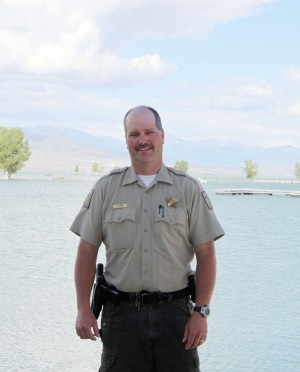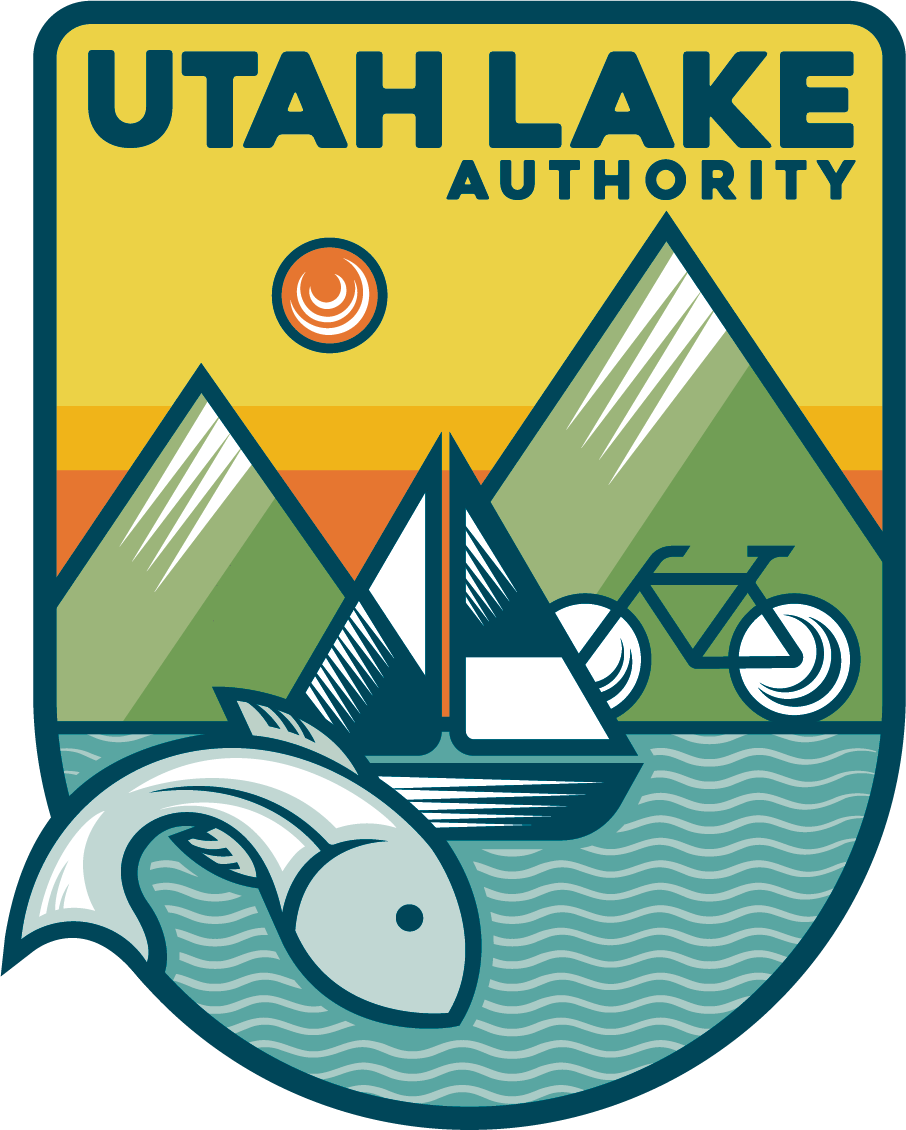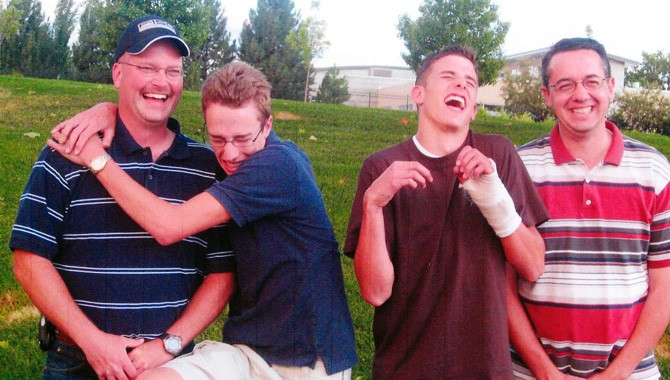Every now and again, our thoughts and perspectives are uplifted by a story. Unexpectedly, someone comes along who unselfishly touches lives and then continues on his or her way, oblivious to the impacts they have had. Some of these are unsung heroes, who report to work every day never knowing what they will encounter. This is the story of one of those days.
It was June 10, 2008. The elements of Utah Lake are unpredictable, driven and influenced by the unstable Utah weather – just wait 20 minutes and it will change as evidenced on that day. It started out as a calm day with two brothers anticipating having fun at Utah Lake. They had decided to test their wave runner on Utah Lake in preparation for a trip to Lake Powell. Their lives and two Utah Lake State Park Rangers’ lives crossed that day and it became a literal life-changing event for all involved.
Utah State Park Rangers, Ty Hunter and Jason Allen, and LT. Dave Bennett, a pilot for Utah County Sheriff’s Office, as well as two brothers, Grant and Steve Hammon, experienced and witnessed this miracle on Utah Lake.

According to Hunter, it was a normal, warm sunny day of work at Utah Lake. He went about his duties as a Ranger at Utah Lake State Park. Allen had just come on shift late in the afternoon when Hunter was briefing Allen of the day’s events. The weather had suddenly changed during the briefing and the forecasted dry cold front from the northwest was coming in and fast, bringing wind and decreasing temperature changes. The wind blew hard, and caused high waves upsetting those recreating on the lake. This would bring a lot of challenges for those not used to the Utah Lake weather.
Hunter and Allen’s pagers went off together calling them to rescue a family of eight whose boat capsized near Pelican Point at Saratoga Springs. Four people out of eight were washed off their boat and they still needed to be rescued. As Hunter and Allen fought six-foot-plus waves and high winds in their rescue boat, they arrived to the location of the family boat and found all who had been on board had drifted safely to shore and were being assisted by other police and fire personnel on shore.
In the meantime, others on the lake were experiencing life-changing situations. A second call came in to the two Rangers about two jet skiers who were stranded out on a defunct watercraft located near the American Fork Harbor.
The Rangers proceeded out across the lake again, towards American Fork and Lindon Boat Harbors searching for the stranded Jet Ski and the boys. After quite a while, the Search and Rescue Plane flown by Lieutenant Dave Bennett, finally saw the boys and flew circles around the area where they were located on the lake, and directed the saving boat towards the Hammons.
Hunter and Allen, even though they were being guided to the Jet Ski location, could not see it due to the wave velocity and height, and weather conditions until they were within 30 yards of it. Hunter and Allen noted the Hammon Jet Ski was bottom up with the two boys holding on to it. When they got closer to the boys, at a distance, they assessed the boys’ condition. Grant was able to respond with a claw-like wave, but Steve exhibited blank stares and no movement. The rescuers realized they better get the two boys aboard soon because the signs of severe hypothermia were present.

Allen was able to throw a rescue rope with a perfect landing the first time, but the wind tossed the rope and bag further away from the Hammons. Allen again attempted to throw the rope, but with no success and the wind just blew it away. Allen was then instructed to use the heavy tow rope to throw to the boys, which landed near them. Hunter and Allen were conscious of taking the steps for safety. They realized people in fear of drowning take desperate measures so they cut the boat’s engines and allowed the rescue boat and then drift toward the victims. This protected the person from being injured by the motors. They did this when Grant took hold of the tow rope. Grant was the only that was grabbing the tow rope, and was pulled in close to the rescue boat. He was hard to pull on board, but Hunter and Allen were not going to lose hold of him! Finally, they were able to pull him onto the boat and place him in a safe place on the deck of the boat and start to focus on Steve. When they turned away from Grant to gather the tow rope to throw to Steve, they saw that he was already at the back of the boat hanging onto the end of the tow rope that was still in the water. “It was a miracle, I was fearful that we might not get Steve to let us help him and he was just there waiting for us. He must of grabbed hold of the end of the tow rope and we pulled him in without knowing. We did not see him we only saw Grant–tunnel vision had affected us both” said Hunter. They rushed to him and began to pull him on board the boat. Steve was disoriented, unaware, and did not want to come on to the boat. He kept gripping and pulling himself towards the outboard motors and fighting against Hunter and Allen.
When they got Steve on board, he lost consciousness and was in the severe stages of hypothermia. They both needed heat and to be out of the wind, so Hunter grabbed a Mylar blanket from the first aid kit and gave it to Allen who spread it over Grant and Steve. However, it blew away while trying to secure it. The rescuers improvised and used a water resistant canvas seat cover from the boat and threw it over both of the brothers with Allen holding it down with his body. Steve was in and out of consciousness not responding to Allen at all. Grant was screaming as an athlete would, giving all that he could to finish a race. “Grant had such a fighting power with his screams telling us he was going to make it,” said Hunter. Hunter and Allen both knew half of the rescue was over, the victims were in the boat, and now all they had to do is get Grant and Steve back to the harbor alive, which is a task with six-foot plus waves and two extremely hypothermic victims. Before getting underway, Hunter radioed in for two ambulances to meet them at the dock. It was a long and slow trip back. The ambulances were there when they arrived and each young man was loaded onto a gurney and taken quickly to the hospital.
“The goal of a rescuer is to get the job done safely and protect those you rescue from what they are being rescued from. The rescuer also tries to protect themselves emotionally by not getting emotionally connected to those they help, but sometimes it is not possible. This case seemed different. From the rescue to the follow up phone call to Debbie Hammon, Grant’s and Steve’s mother — it was special and I was connected. I watched Grant’s and Steve’s interview on channel 2 and my heart went out to them for the ordeal they went through before we got to them. Grant was not going to lose his brother and he was stern and hard, telling Steve to hold on and wait. They were cold, and the weather and waves were getting worse. Things were getting extremely dangerous for the boys. They were lucky because their time was going quickly. We, as a rescue team, were in the right place at the right time,” said Hunter.
Hunter and Allen were exhilarated by the success of rescuing these two boys and the dedication the brothers had to each other. They knew if they were not there, it would have had a different outcome. “There were mightier hands than ours that helped us and those boys that day,” Hunter said.
Hunter holds the Utah County Sheriff’s Office Search and Rescue team in high esteem. He felt Utah Lake has the best collaborative team of rescuers, who come together to assist those who require their services. “It is a team I am proud to be a part of successful rescues like Grant’s and Steve’s. It could not have happened without all the team being there and assisting each other,” Hunter said.

Lieutenant Dave Bennett of the Utah County Sheriff’s Department had been a pilot for over 28 years and assisted on over 500 rescues. He was the one who bird-dogged the skies to find the Hammon brothers.
“It would be difficult to see them from a boat, even within 100 feet of them. With the winds blowing, it caused a low profile to be seen. But from the airplane, I was able to spot them and directed the Rangers in the boat to the overturned Jet Ski. We were talking on the radio the entire time so they could find them” said Bennett. He said the flight was windy and rough. His passenger was sweating and “turned green like Utah Lake.” “When you get in a tight turn, you need to keep focused because you can lose your visual contact, so as a pilot you need to focus,” he said.
Park Ranger Jason Allen, who worked with Hunter, said they are generally called out on rescues several times a year. “I thought the call was routine until we found the brothers in the water and their conditions had changed, as well as the water conditions.” Allen knew it was team effort, when the county search and rescue were able to port them. “The wind was pushing them farther out, and it would have been ‘iffy’ to find them. The waves were five to six feet that day and the wind was going at a fast pace, with the wind causing the high waves.”
Lt. Bennett said, “I could tell from the air they were not doing well. They were lethargic and it appeared it would be very difficult to see them from the rescue boat.”
After Allen and Hunter reached the young men, trying to approach them and get close to help was almost impossible due to the high waves. Allen said, “After two to three tries, we maneuvered the boat. [Hunter] was the boat pilot, and I was the deck hand trying to reach them. After several tries, we were able to pull them out of the water. We were able to bundle them up the best we could with what was on board the boat. Grant was officially unconscious, and Steve was awake but not coherent. Getting them back to the Provo marina was the best and quickest choice.”
“I didn’t know the seriousness of how bad they were,” said Bennett. “They had been in the water two to three hours and were quite hypothermic.”
Realizing the impact he, Hunter, and Bennett had, Allen said, “I got a lot of personal fulfillment from that day. It was busy day for rescues, and the boys were the second call. A third call came in an hour later for a rescue at Lincoln Beach where boaters were stranded. It was good to have a positive ending.”

Debbie Hammon, the mother, received a call from the friends. The wave runner and the boys were missing and a storm was coming up. “When I have crisis, I went into adrenalin mode ready to respond.” She received a call later stating they were found and were being taken to the Utah Valley Regional Medical Center.
“I had no idea of the seriousness of the situation until later. I thought I was just going down to pick them up. When I got there, they took me in to see them. Steve had just regained consciousness and I was able to talk to him. Grant was a little confused but he was able to respond. I was met at the door by a social worker. That should have alerted me, but I was oblivious and I was able to be positive. But as the day wore on and I got bits and pieces, and I understood the seriousness that the boys had been on the edge of life.”
The water temperature was 63 degrees. When the body goes into hypothermic condition, it releases large amounts of lactic acid disrupting the body’s natural balance. Because of this, the boys’ muscles were very sore and painful. The boys’ core body temperature was 82 degrees, which is very dangerous. I was totally unaware of the how critical their condition was. I have come to know the rescuers and we are very grateful to each and every one of them for their efforts.”
About a year after the rescue, Steve and Grant Hammon and their family came back to Utah Lake to meet their rescuers. Over dinner, they recalled the rescue and exchanged stories of that day. It was a meeting, which solidified a friendship to this day between the four people, Jason Allen, Steve and Grant Hammon, Ty Hunter and the rest of the Hammon family.
(Stay tuned as these stories are retold from the perspective of both Grant and Steve.)

